Peter MALONE
Saturday, 18 September 2021 19:43
Schlock / Future Schlock
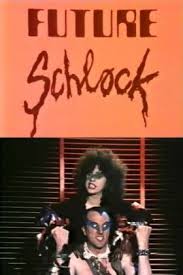
SCHLOCK (FUTURE SCHLOCK)
Australia, 1984, 85 minutes, Colour.
Maryanne Fahey, Michael Bishop, Tracey Callander, Tiriel Mora.
Directed by Chris Kiely and Barry Peek.
Future Shlock is the first of four very small-budget Melbourne films made by Barry Peek and Chris Kiely: Channel Chaos, As Time Goes By, The Big Hurt.
The film is a satire on the future – suburban people are very much Stepford robots and have conquered any nonconformist. However, the film focuses on two nonconformists who try to upset society. A curiosity item.
1. What was you overall response to this film? Was it enjoyable? What aspects of it were enjoyable? Why was it made?
2. How clever was the film? Many reviews said it was not clever at all. Do you agree?
3. The film was a parody. How clever do parodies have to be? Why are parodies made? Are they meant to stand on their own? How do they relate to the original? Do they destroy the original? What kind of film was this film parodying?
4. What insight into the American mentality? Sense of humour, sense of mockery? How much successful parody of science fiction, King Kong type films?
5. How was the film a satire on American behaviour? People confronted with the animals? People confronted by the murders, the police, family life? In which characters was this most obvious?
6. Comment on the parody of such films as The Planet of the Apes, The Boston Strangler and other mass murder films, 2001 with the ape and the throwing of the rock through the shop window, the romance of Elvira Madigan and Mozart’s music, the conception of Schlock and King King, science fiction films about the missing link, the end with its direct quotation from King Kong? Was this cleverly done and worth doing?
7. Did the Schlock have a character? How did the film attempt to portray its character? In the situation and confrontation with others, the murders, the moving around the town, the ending? Were any other characters well portrayed?
8. Was there any message at the end of the film as in King Kong and Beauty destroying the Beast? Or, was this mere mockery?
9. Did this film enhance or debase the original which it parodied?
Published in Movie Reviews
Published in
Movie Reviews
Tagged under
Saturday, 18 September 2021 19:43
Searching Wind, The
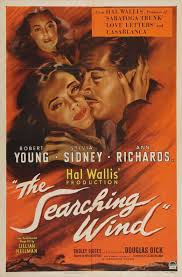
THE SEARCHING WIND
US, 1946, 108 minutes, Black and white.
Robert Young, Sylvia Sidney, Ann Richards, Dudley Digges, Douglas Dick, Albert Basserman, Dan Seymour, Ian Wolfe, Norma Varden.
Directed by William Dieterle
The Searching Wind is based on a play by Lillian Hellman. Lillian Hellman took strong social stances, her plays including The Children’s Hour as well as the book Scoundrel Time, her recollection of the Mc Carthy era. A number of her plays were made into films including The Little Foxes with Bette Davis.
This film ranges over the decades. While set in 1946, it goes back to the 1920s with Robert Young as a diplomat in Italy, Sylvia Sidney as a journalist with whom he is in love. However, she denounces him for his hesitation in attacking Mussolini and fascism. In the meantime he marries socialite, Ann Richards and they have a son, Douglas Dick. It is the son who confronts the two women at the end of World War Two, revealing a story about his father’s activity during the war.
The film is interesting in its themes – however, the pruning of the dialogue of the play has not been extensive enough and the critics complained that this was something of a difficulty, too many words!
The film was directed by William Dierterle, the German director who made an impact with his biographies at Warner Bros in the 1930s: The Story of Louis Pasteur, The Life of Emile Zola, Juarez, Doctor Erlich’s Magic Bullet, A Dispatch From Reuter’s. He also directed the celebrated Hunchback of Notre Dame.
1. What did the title mean?
2. Comment on the structure of this film and its effectiveness especially the use of the flashbacks after a lengthy introduction.
3. The film opened with a marriage breaking up and the presentation of husband and wife as well as father-in-law, son and 'other woman'. Did you make any judgments on the rights and wrongs at this stage of the film? If you did, did you have to change your ideas an the film went on? Why?
4. How was Case introduced into the film? Did you like her?
5. What did the flashback situations have in common as regards politics: Rome 1922, Berlin in the late 20s? Spain during the Civil War, Paris 1938? Why were these places chosen? What was the message?
6. How did the coming of Mussolini and Fascism affect Alex, Case, Emily and her father? How did each of them react? Whose reaction elicited your sympathy most? Why?
7. How was Emily 'involved' in the life of the country in which she lived? especially in Pre-war Paris?
8. How was Cans involved in each country? Did you share her political views? Why? (Would she have been acceptable for her views in the 1920's and 1910's? Would cinema audiences have been sympathetic to her views in 1946? why?
9. How was Alex involved in each situation? Was he well equipped for his diplomatic roles? How much did his own temperament, character and emotional tensions of the time influence his views and decisions on the political scene? Note his absorption in marriage in 1922, his diplomatic status in Berlin, his concern about keeping Sammy out of a war when he dictated his despatch to Washington in 1938? Trace the growth of the three main characters through these two decades and their emotional and political changes.
10. Alex thought always that everything would be all right, that appeasement(and compromise) was the safest and easiest policy? How wrong was he? in the political scene? in his own life? (How dangerous is it for a nation when its politicians observe and make decisions acccording to their own emotions and tensions?)
11. Why did Alex marry Emily? Could the marriage have worked?
12. Why did Case not marry Alex? Were her reasons right? How hard was this decision for her? How strong was her character?
13. After the flashbacks, what was the emotional mood of the dinner? Did you understand the relationships better? Had your judgments changed? Did the revelations help Sam?
14. How did each of the main characters react to the revelations, well, or according to their previous form?
15. Was Case right in still refusing to marry Alex? Why?
16. What role did Saw play? Was his leg amputation important to the theme of the film?
17. Why does the super-patriotism of the ending jar on us today? What impact would it have had in 1946? Why?
18. What techniques of the film-making have changed since the mid-40s that make this film easily recognisable as a film of those years? Do they spoil the film or merely place it in its chronological position? Why?
Published in Movie Reviews
Published in
Movie Reviews
Tagged under
Saturday, 18 September 2021 19:43
Second Time Around, The
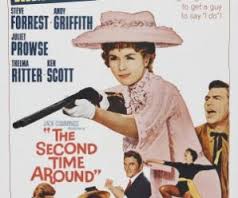
THE SECOND TIME AROUND
US, 1961, 99 minutes, Colour.
Debbie Reynolds, Steve Forrest, Andy Griffith, Juliet Prowse, Thelma Ritter, Isabel Elsom.
Directed by Vincent Sherman.
The Second Time Around is best described as a Debbie Reynolds vehicle. Debbie Reynolds was always a lively presence in films, right from the beginning in such films as The Daughter of Rosie O’ Grady and Two Weeks With Love. She emerged centre-screen in Singin’ in the Rain. She appeared in a number of MGM musicals but, at the end of the 50s with the demise of the musical, she appeared in many comedies. This is one of the best – and typical of her. She is a widow with two children, leaves New York, goes to Arizona, sets up a ranch, becomes the mayor. She has two leading men vying for her attention: Steve Forrest and a young Andy Griffith. There is humorous support from Thelma Ritter, as always.
1. The meaning of the titte, reference to marriage, to Lucretia?
2. How well did the film combing the conventions of the Western, the comedy, the period drama?
3. The importance of the photography, colour, locations, the West and its scenery, towns? Musical background?
4. How credible was the plot? The role of the young woman in the west, the western conventions and characters, her behaviour, the search for gold, becoming sheriff? Did the reality of the plot matter?
5. How attractive a character was Lu? As a widow in New York, her relationship with her children, with her mother-in-law? Her hopes for the west, her arrival and failure to get a job with Jones, the attentions of Collins? The importance of her work with Aggie and the film’s collage of all her hard working efforts? Her settling into the town? Her gaining the attention of both Collins and Jones? Her falling for Jones, the search for gold, the question about roasxy and his role as sheriff? Her standing for election and winning, her strength in standing up to the criminal element? Her final love for Jones and the children coming out? The screenplay for a heroine of the west? Debbie Reynold’s contribution to this role and making it attractive and believable?
6. Hour conventional a smooth gambling man of the west was Jones? the humorous touches in his portrayal, his fear of her being a widow and with children? His relationship with Rena, his devising the gold search in order to woo Leucria? Her reaction to him, imprisonment and final help? The contrast with the character of Collins? The homespun man of the west, dependant on his mother, paying court, yet attracted to Rena?
7. The minor characters, especially Aggie as the tough elderly woman of the west, with the kind heart? Her helping of Lu especially with money and with the law? Rena and the town dance and her devotion to Collins? Mrs Rodgers and her harsh attitude to her daughter-in-law?
8. The people of he town, the sheriff and his harshness, his bullying of the Mexicans, of the Indians? His standing up to Lu and her reaction towards him?
9. How well did the film explore the themes of the west, of frontier land, survival, law and justice? The particular emphasis on women and their role and their rights? A satisfying comedy western?
Published in Movie Reviews
Published in
Movie Reviews
Tagged under
Saturday, 18 September 2021 19:43
Second Wind
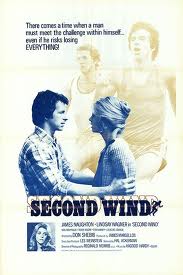
SECOND WIND
Canada, 1976, 99 minutes, Colour.
James Naughton, Lindsay Wagner, Ken Pogue.
Directed by Donald Shebib.
Second Wind is about a very busy executive who takes up jogging. Dissatisfied with his work, his home life, himself, he begins to indulge in the jogging, becoming a strong runner. This demands more and more of his time and he faces crises in relationships with his wife, with other women, with his family, and has to make decisions about his future. This is a variation on the midlife crisis and the tedium of suburban life as well as the dissatisfaction with striving for accomplishment in business. James Naughton is good in the central role and is supported by Lindsay Wagner who was popular on television as the Bionic Woman.
The film was directed by Canadian Donald Shebib who made a number of small-budget films in his native country including Going Down the Road, Fish Hawk. He also directed another film about running, The Athletic Indian played by Robbie Benson, Running Brave.
1. The meaning of the title, themes?
2, The quality of this film as Canadian, as made in the atmosphere of the 1976 Olympics? Its impact in that situation, now?
3. The qualities of the production, locations, colour and music, the special sequences for the running, the race? How did this engage audience attention?
4. The film's identification with Roger and his ambitions? How did it help the audience to identify with him? Its placing him centrally in focus, his ambitions, difficulties, his exhilaration?
5. How was Roger a typical modern man of the cities, of big business, of his job, of the pressures of time, of the directions of achievement, of capacity and incapacity for relationships? How much insight in theme came from Roger's character?
6. The impact of the opening and the entry into the world of stocks and shares, noise, big business, deals? The attention to detail in this opening? The portrayal of the men in the Stock Exchange, the various types and their attitude towards work? Frank and his lack of ambition, his emphasis on sex? The bosses and their capacity for administration, seeing talent, helping those on the way up? Simon and his help and his subservience? Roger situated in this world? How well did we understand him through this world? His ambitions?
7. Roger and the portrayal of his skills, the impact on his promotion, the fact that this dissatisfied him? His explanation that things had come too easy? What more did he need?
8. The portrayal of home life, the home itself, Linda and her style? the atmosphere of family, recreation, work? Friendship with neighbours, working on the television, racing to see the race? Meals, lovemaking? How genuine did this family life seem?
9. Why did the television interview about the runner make such an impact on Roger? Why did he begin to run? The film's portrayal of the physical and psychological struggle? The energy and effort that Roger made? Seeing this in the light of the quotation from Thomas Merton at the beginning of the film?
10. How impulsive was Roger? How did he control himself in training, how did the running become an obsessive, a skill? The influence of Pete and his way of training Roger? His promise to bring the experts? Roger striving towards goals?
11. How well delineated was the character of Linda? The fact that she did not understand Roger and his running? The scenes of her shopping with her friend and trying to talk with her friend? Her attempts to share Roger's life, the track suit and the running? Her decision in the light of what she considered his deceit? Was she right to leave home? Her surprise at Roger's reality of running? The fact that she came the race at the end?
12. The contrast of Linda with the girl in the car? Her obvious chasing of Roger? Her capacity for listening and helping Roger to understand himself? How well delineated was the character of this girl?
13. The importance of the decisions facing Roger? To give up, to achieve something inside him? His talking to the coach? His going away to train for a week?
14. What were the terms of the trials and the need for decision for Roger? The reasons for and against his decision to run? How much insight into the nature of this for the man aged 30?
15. The dramatic presentation of the race? How enjoyable and involving? Why? Linda and Kevin oozing? The sense of achievement for Roger? What had he achieved?
16. How telling a parable was this about modern man and his ambitions and achievement? The validity of sport as a symbol for exploring modern man?
Published in Movie Reviews
Published in
Movie Reviews
Tagged under
Saturday, 18 September 2021 19:43
Secret Agent, The
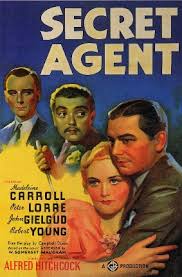
THE SECRET AGENT
UK, 1936, 86 minutes, Black and white.
John Gielgud, Madeleine Carroll, Robert Young, Peter Lorre, Lili Palmer.
Directed by Alfred Hitchcock.
The Secret Agent is a Hitchcock film from his thirties British period. It comes from the same period as The Man Who Knew Too Much, The Thirty Nine Steps and Sabotage. It is quite enjoyable and comes from a Somerset Maugham novel.
The rather stiff hero is played interestingly by John Glelgud. Madeleine Carroll, who was in The Thirty Nine Steps, is an attractive heroine. Peter Lorre, who was in The Man Who Knew Too Much, is an odd villain. Even more surprising in Robert Young as a very suave villain. The film takes up many of Hitebock's favourite themes of the time and of later films, espionage, murder, mistaken identity, surly heroes and attractive villains, blonde heroine. He also raises questions about the wrong man which he was wont to do in so many films, especially the obligations that a secret agent takes to obey orders, even to killing. The film is very entertaining, a strange blend of melodrama and action and tongue-in-cheek comedy.
1. The film an an example of early Hitchcock, his work in Britain?
2. The origins of the film in the writings of W. Somerset Maugham? Ashenden as a Maugham hero? Maugham's attitude towards war?
3. The qualities of British film-making in the thirties, black and white photography, the use of studios and of the stars?
4. The importance of the opening and the mock funeral? The solemnity, the sudden revelation of humour and irony? Indication of double tone to the whole film: serious espionage drama, problems of conscience about murder, black humour pervading the atmosphere? (Hitchcock's trade mark over many decades?)
5. John Glelgud's style as Ashendon? The build-up to establishing his mission and his loss of his personal Identity? The information in the newspapers? the supplying of Elsa, as his wife? The General an his assistant? The journey to Switzerland, the atmosphere of Switzerland? Ashendon as the British agent abroad? The series of adventures that he was involved in? The serious tone especially in the sequence in the church, the importance of killing an unknown victim? For patriotic reasons? The repercussions of the death of the wrong man? The relationship with Elsa, the relationship with Mary? his ability and inability to kill? The emergence of conscience and the moral dilemm?
6. The contrast with Elsa and her excitement about such a salon? Her being confronted by the realities of death instead of romantic excitement? The sequence with the man being pushed over the cliff and her reaction? Her involvement with Mary in and the gradual realization of the truth? her attitudes towards him at the end? The comparison of Ashendon and Elsa's attitudes towards death and killing?
7. The ambiguous character of the general? The humour about his woman, - the seriousnoss of his capacity to build? The comedy consequences in sequences Switzerland? The sinister build-up to his killing the innocent victim on the mountain? his own death? Peter Lorre's style?
8. Mary as the obtrusive American? The suave romantic type? When did the audience suspect that he was the villain? His change of pace and tone on the train? His death?
9. The portrait of the man who was killed, the circumstantial evidence, his climbing the mountain and the General's presence, Ashenden's presence? His wife and the dog and Elsa's presence? The atmosphere of suspense and conscience with the editing?
10. The build-up to the sequence in the church and the revelation of the murder?
11. Hitchcock's techniques with train adventures? The crash and its repercussions?
12. Themes of espionage and conscience, war? The serious comrdy style as a vehicle for the exploration of these themes?
Published in Movie Reviews
Published in
Movie Reviews
Tagged under
Saturday, 18 September 2021 19:43
Secret Life of an American Wife, The

THE SECRET LIFE OF AN AMERICAN WIFE
US, 1968, 92 minutes, Colour.
Walter Matthau, Anne Jackson, Patrick O’ Neal, Edy Williams.
Directed by George Axelrod.
The Secret Life of an American wife was written and directed by George Axelrod, writer of such films as The Seven Year Itch and How to Murder Your Wife (as well as the more serious Breakfast at Tiffany’s and The Manchurian Candidate).
Perhaps Axelrod was influenced by such continental films as Belle de Jour with Catherine Deneuve. In that film, Deneuve plays a housewife, bored with her life, who becomes a callgirl by day and wife by night. In this American variation, Anne Jackson portrays a bored suburban housewife who becomes a callgirl for a movie star (played by Walter Matthau) in order to prove that she is still attractive to her husband, Patrick O’Neal?.
Some eyebrows were raised at the film at the time of its release, although it reflects the change of perspectives on presenting moral values on screen of the 1960s. Walter Matthau who had won an Oscar in 1966 for The Fortune Cookie made a number of prominent films at this time including The Odd Couple, Cactus Flower and Hello Dolly.
1. The appeal of this kind of sex comedy? Laughter, mockery, moralising, observation, a criticism shown humorously of American moral attitudes? Was the film an overall success?
2. What were the emphases in the comedy: in character, situations, the American way of life?
3. What were the basic moral stances taken by the screenwriter? The American code, traditions? The questions about external American morality and what goes on in people's minds and hearts? How trite did the treatment seem, how true?
4. The focus on the average American wife, as portrayed by Ann Jackson? What type of person was she? The importance of her monologues, the communication with the audience and the audience able to identify with her? Middle age, the nature of her memories, her growing up? The truth about the past and
her romanticising of it? Her longing for the past, her satire on the present?
5. How did the film move to the focus on sexuality? Questions of age, memory, people getting used to one another, the sexual appeal? The humour of her encounter with the milk boy and his not noticing her? The nature of her
yearnings? The irony of the call-girl as a symbol for her yearnings? Audience response to this kind of symbolism?
6. How was Tom, her husband, presented? Realistically, satirically? The relationship between husband and wife? The memories of their past, that they had got used to one another? His involvement In his work, his lies and his smiling, the artificiality of advertising, of being an agent, of
providing for the needs of someone who was despised? The fact that he was a slave to his job and to the movie star?
7. The satire on the movie star, Walter Matthau's style? The parody of the Moll-type, his self-regard, his poses, his physical look, his fans? His difficulties and pettiness as regards the piano, the room and his meals? How accurate was the parody of the movie star?
8. The importance of the encounter between Charlie and Victoria? who learnt the truth? What were the true sides of each of them? The motherliness and the wife attitudes of Victoria? The ordinariness and emptiness of the star?
The significance of their talk and encounter, Victoria's fussing over Charlie's illness? Comment on the sexual symbolism of their union and its value? The significance of Victoria's succeeding as a call-girl and her being paid
the money?
9. What was the achievement for Victoria? How questionable was the morality of this? The relationship then with her husband?
10. Comment on the incidents and the comedy highlights and their success? Their balance within the themes?
11. The importance of the minor characters, for example the assistants to the film star, the woman Susie Steinberg of the imagination? The children?
12. The emphasis on the title was 'the American wife'. What kind of Americana was this film? As a reaction of the sixties?
Published in Movie Reviews
Published in
Movie Reviews
Tagged under
Saturday, 18 September 2021 19:43
Secret Life of Walter Mitty, The
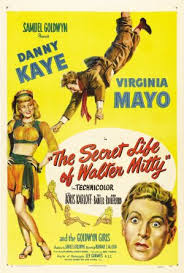
THE SECRET LIFE OF WALTER MITTY
US, 1947, 110 minutes, Colour.
Danny Kaye, Virginia Mayo, Boris Karloff, Fay Bainter, Ann Rutherford, Florence Bates, Reginald Denny.
Directed by Norman Z. Mc Leod.
The Secret Life of Walter Mitty is a classic story by humorist James Thurber. It was an ideal vehicle for Danny Kaye and his style of comedy, verbal patter, impersonations. Here he plays a comic book writer who spends his time daydreaming. He also has an overprotective mother. He imagines himself as a hero with great adventures (which would make him at home in the cinema post-Superman of 1978 and all the Marvel Comics characters). There were plans to have a remake in 2009 with Mike Myers (Austin Powers) as Walter Mitty.
Danny Kaye had been successful on the Broadway stage. He had made a transition to film with Up In Arms, Wonder Man, The Kid From Brooklyn and was to have great success especially during the 1950s with On the Riviera, Hans Christian Andersen, The Inspector General but, especially, Knock on Wood and The Court Jester. Virginia Mayo appeared with him in several of his early films. There is a good part for Boris Karloff, bringing his memories of Frankenstein, and a contrast with the gentle Fay Bainter as Walter Mitty’s mother. Director Norman Z. McLeod? had been making films since 1928. during the 1940s and 50s he made quite a number of comedies including The Kid From Brooklyn, Road to Rio, The Paleface, with Bob Hope, as well as My Favourite Spy and Let’s Dance with Fred Astaire and Betty Hutton.
1. The classic status of this comedy? A Danny Kaye film with the classic presentation of his comedy style? The character of Walter Mitty and his place as a byword of the man with fantasies? The background of James Thurber and his ironic insights into the American male?
2. The qualities of Danny Kaye's comic style, his presence, clowning, humour, music and song? The place of this film within his career?
3. The film as a comedy of the forties: glamorous, slapstick humour, verbal, musical? The role of fantasy? The parody of cinema styles?
4. The film an a piece of Americana? The mood of post-war America, the presentation of New York and the way of life in the city, Walter Mitty and his work, transport, home, office? Walter Mitty as identifiable with?
5. Danny Kaye's interpretation of Walter Mitty as the ordinary man, the everyman of contemporary America, the type, his dreams? His being bound into the world and his desire to escape? Fantasy and realism?
6. The humour of the presentation of Walter in real life: his home life, the attitudes and comments of his mother, fiancee? His travelling, work? His admiration for the girl of his heart from afar? His shyness and awkwardness? The irony of his eventually meeting the girl? The quality of comedy detail?
7. Comment on the impact of the fantasies and Danny Kaye's humour? the R.A.F. pilot, the Mississippi river boat gambler, the eminent surgeon, mad musician. tough envoy, hat designer? The 'Anatole of Paris' song? Virginia Mayo's presence in these fantasies?
8. The character of the girl? In fantasy, in reality? Her satire in the fantasies? James Thurber and his insight into the battle of the sexes?
9. How humorous and interesting were the final incidents, the plotal Boris Karloff's presence and the sinister values? The threats to Walter Mitty?
10. How satisfactory the resolution and tho feeling that the audience was left with? Audiences identifying with Walter Mitty and his ambitions and dreams?
Published in Movie Reviews
Published in
Movie Reviews
Tagged under
Saturday, 18 September 2021 19:43
Secret of Dorian Gray, The
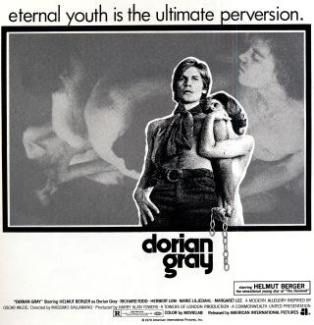
THE SECRET OF DORIAN GRAY
UK/Italy/West Germany, 1970, 101 minutes, Colour.
Helmut Berger, Richard Todd, Herbert Lom, Margaret Lee, Maria Rohm, Beryl Cunningham, Isa Miranda, Eleanora Rossi Drago, Marie Liljedahl.
Directed by Massimo Dellamano.
The Secret of Dorian Gray is loosely, very loosely, based on Oscar Wilde’s novel. This is a sexploitation variation (although some of the cast, including Richard Todd, said they did not realise this at the time of shooting it). Helmut Berger had appeared for Luchino Visconti in The Damned in 1968 and was to appear in his Ludwig. Berger became something of a gay screen icon. However, he is supported by such respectable stars as Richard Todd and Herbert Lom as well as several veteran Italian actresses.
The film focuses on the sexual perspectives of the Dorian Gray story and his eternal youth as well as his relationships.
Direction is by cinematographer Massimo Dellamano who made a number of exploitation films at this time including Venus in Furs and A Black Veil for Lisa.
1. This film was based on and English classic. How much influence did the original have? The previous film version?
2. The value of a remake, the value of a remake transferred to the 1970s? The titles: the original German 'The Picture of Dorlan Gray', the English 'The Secret of Dorian Gray', the Italian 'The God Called Dorian'. The indication of attitudes of the film-makers from these titles?
3. How effective was the fable in the late 19th century? Corresponding to Oscar Wilde's interests and philosophy? A fable for the decadance of the late 19th century, exterior refinment, interior corruption? The relevance of this to the 20th century? To the 1970s? The film declared that this was an allegory updated. How effective was the updating, the application of the allegory?
4. Did the film explore evil and corruption? Henry Wotton and his expression of the philosophy of good and evil, morality and immorality? How did the film exploit its theme?
5. Helmut Berger and his appearance and style as Dorian Gray? A potentially decadent young man? Initial strengths and weaknesses of character, youth, the world in which he lived, the initial impression from the nightclub? His amoral attitudes, swinging style? The importance of the portrait, his relationship with Basil? The portrait and its impact on bis life? The portrait corrupting as he remained the same? The effect on him with the gulling of conscience, the relying on externals and the ignoring of interior corruption and its consequences? The people with whom he mixed, his relationship with Henry Wotton and his sister, Mrs Ruxton? His using and abusing people? The decadent atmosphere, sexuality, homosexuality? The quality of pleasure that he derived from this decadent life? Decadence leading to violence? An allegory of the downfall of an ordinary young man?
6. The portrait of Basil, as a man, friendship with Dorlan, rich type, his painting of the portrait? His influence on Dorian's life, their clashes? Painting the portrait to give Dorian some life and yet it being the cause of his death?
7. Henry Wotton and his influence on Dorian's life, his wealth, homosexuality, philosophy of good and evil and pleasure, his continually tempting Dorian, tempting him to sell himself? Henry Wotton as an elegant corrupt man? The equivalent also of a portrait?
8. The films presentation of women, Gwendoline and her relationship with Henry, her voracious attitude towards Dorian? Mrs Ruxton and her wealth, sexuality, the gross exercise of sexuality, for instance at the races? Their hold on Dorian, his use and abuse of then?
9. The contrast with Sybil and her refinement, her love for Dorian, innocence, Shakespeare, the fulfilment of their law on the stage and the background of Romeo and Juliet? (Appropriate, pretentious?) Their clashes and her not understanding, the pathos of her suicide? Its effect and lack of effect on Dorian?
10. How well did the film trace his decline, the corruption in the portrait?
11. The final irony of his encounter with Gladys and Alan, his destruction of them both?
12. Was the ending inevitable? His violence against himself, bringing about his own destruction and death? A pathos fable?
Published in Movie Reviews
Published in
Movie Reviews
Tagged under
Saturday, 18 September 2021 19:43
Secret of the Incas

SECRET OF THE INCAS
US, 1954, 100 minutes, Colour.
Charlton Heston, Robert Young, Nicole Maurey, Thomas Mitchell, Glenda Farrell, Michael Pate, Leon Askin.
Directed by Jerry Hopper.
Secret of the Incas is one of the many action adventures directed by Jerry Hopper during the early 1950s. He was to work with Charlton Heston in Pony Express, Private War of Major Benson and One Desire.
This is an adventure set in the Andes, adventurers from the United States in search of treasure, Charlton Heston as the hero, Thomas Mitchell as a shady adventurer. Robert Young appears as a doctor and Nicole Maurey as an archaeologist. Michael Pate portrays one of the Incas.
The film is quite predictable in the setting up of the search, the confrontations, the triangle romance, the presentation of the Incas. Nevertheless this was a fairly unpretentious film of the 1950s – and this kind of storytelling still remains entertaining pastime,
1. Was this a good adventure film? Was it too conventional? Or did it have original ingredients well presented?
2. How typical an adventure film of the fifties was this? Would it have been made differently now? In what way?
3. The importance of the mountain locations for the film's success? Peru, the style of the mountains and ruins for the Inca atmosphere? The value of the introduction?
4. The film as an adventure quest? The reality of greed? What attitude towards good and bad did the film show? its mixture in each of the characters? Did this make it seem real rather then just comic strip heroism?
6. Was Harry Steele a good hero? Charlton Heston style? As bad and on the make? Audience sympathy for him? His self-resources and vanity? His using of Elana at of the Romanian consul? The clashes with Morgan? What affected his change? The influence of Elana? His quest for the golden wealth and his change?
8. How interesting a character was Doctor Morehead? Was he a credible archeologist? The film's interest in showing what he was doing and its value? Drama-wise as a balance to Harrry Steele? Different character? As a rival for the affections of Elana? The credibility of his proposing to her? Her final rejecting of him? Why? What values did he stand for?
9. Morgan a convincing villain? His age and weight? His greed and the quest for gold? The importance of the mirror theme: as his being a mirror of what Harry Steele would be like? The influence of this mirror theme on Harry's behaviour? The melodramatics of his death?
10. How well did the film give the atmosphere of Cusco? The visitors, the planes, the thin air, the seedy atmoophere, the university where Incan was learnt?
11. How did this contrast with the jungle and the mountains, the village and the ruins?
12. How well did the film portray the Inca background? the quest for the sunburst for the Incas themselves? The importance of songs and the Inca dances? The legends? The association of the sunburst with civilizations and their being lost?
13. What values did the film presuppose in its audience? The audience response to such adventurea? Did it satisfy audience expectation?
Published in Movie Reviews
Published in
Movie Reviews
Tagged under
Saturday, 18 September 2021 19:43
Secret Six, The
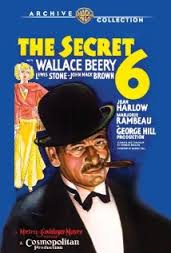
THE SECRET SIX
US, 1931, 83 minutes, Black and white.
Wallace Beery, Lewis Stone, Johnny Mack Brown, Clark Gable, Jean Harlow, Marjorie Rambeau, Ralph Bellamy.
Directed by George W. Hill.
Clark Gable's fifth film. It was also an M.G.M. contribution to the gangster genre that was developing at this time: Little Caesar, Scarface, Public Enemy. While this film has the M.G.M. gloss, director George Hill was apparently influenced by German styles and adapted these to the American scene - for example, skyline silhouettes, superimpositions and collages, a sinister deaf mute along the lines of Peter Lorre. The film was considered brutal and bloodthirsty in its time and banned in several places.
The film shows, as with so many of the time, the rise of a petty hoodlum played by Wallace Beery into a power behind a mercenary governor. Beery, a worker in a slaughterhouse, becomes involved in crime and gradually moves to the top. It is an eccentric performance for Beery is a milk-drinking, satin pyjama-wearing slob. He does not lose his rough manners even at the top until, with so many killings, he goes to prison to face justice along the lines required at the time. It is an interestingy if sketchy, performance of a hoodlum.
Lewis Stone gives a studied performance as the aristocratic mannered mayor who backs Beery and suffers the consequences. There are interesting brief performances by Marjorie Rambeau and Jean Harlow as gangsters' molls. Harlow has a few brief encounters with Gable in this film - and was soon to meet him in Red Dust, Wife Versus Secretary, Saratoga. There are interesting supporting roles for John Mack Brown and Ralph Bellamy.
The Secret Six are an odd group - rather like comic book characters meeting to discuss the fight against crime but wearing masks which, presumably, are meant to conceal their identity. This has the echo of the serials so popular in the thirties and forties.
Clark Gable is a newspaper reporter - the kind of role he was to play many times afterwards. He is eager, unscrupulous, openly mixing with the gangsters to get stories, repentant when there is human interest, and on the side of the Six in their fight against crime. He happily rushes off on a new assignment at the end of the film.
The film is of historical interest for the gangster films of the early thirties, for M.G.M. production values, for the early work of Clark Gable and Jean Harlow. It raises the usual questions of social comment on the American cities, crime and politics, the power and brutality of hoodlums, ordinary citizens suffering violence, the administration of justice.
Published in Movie Reviews
Published in
Movie Reviews
Tagged under